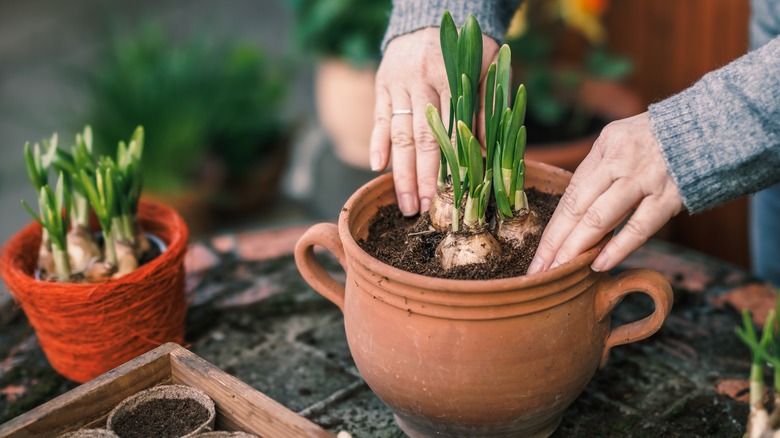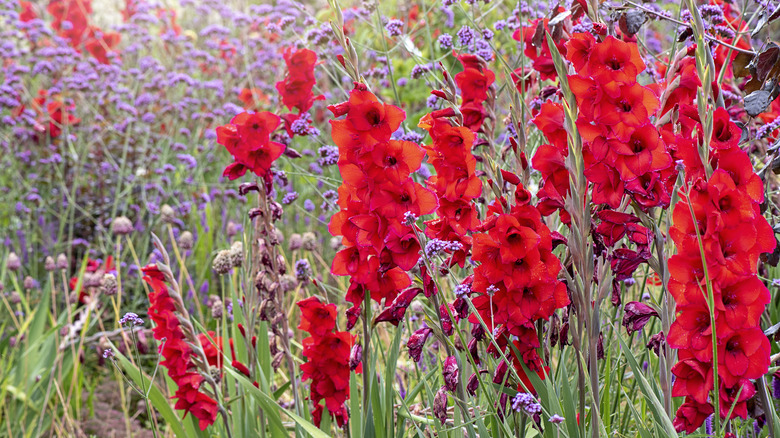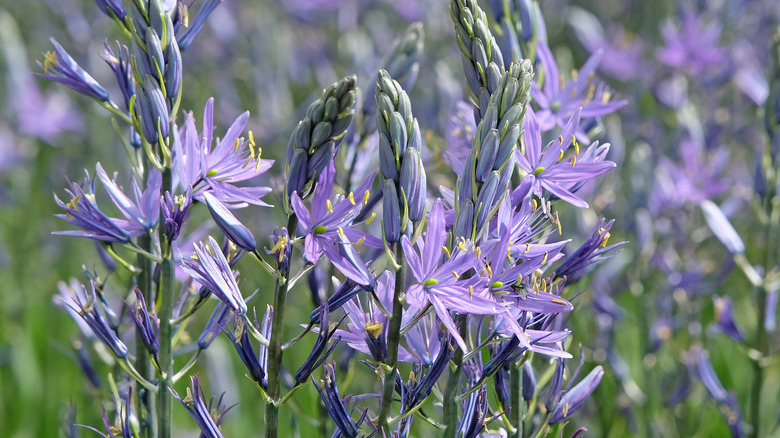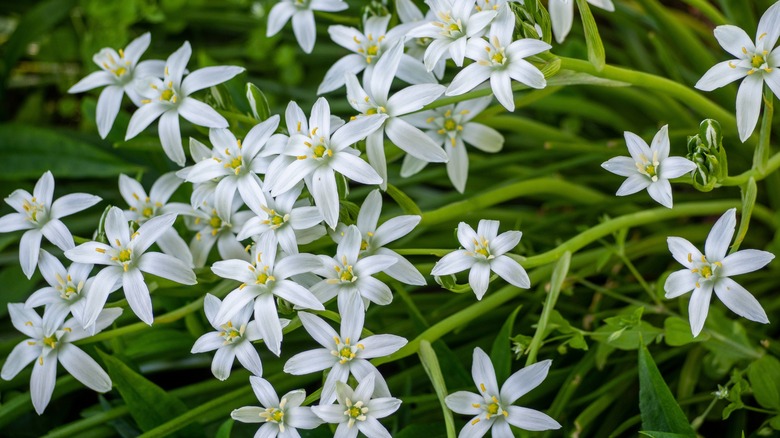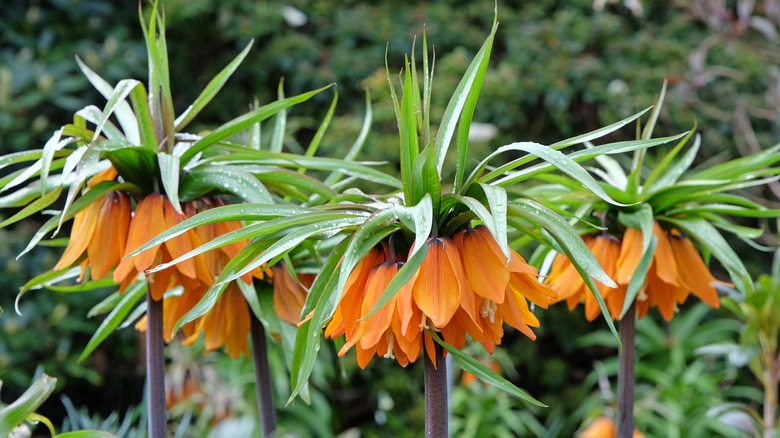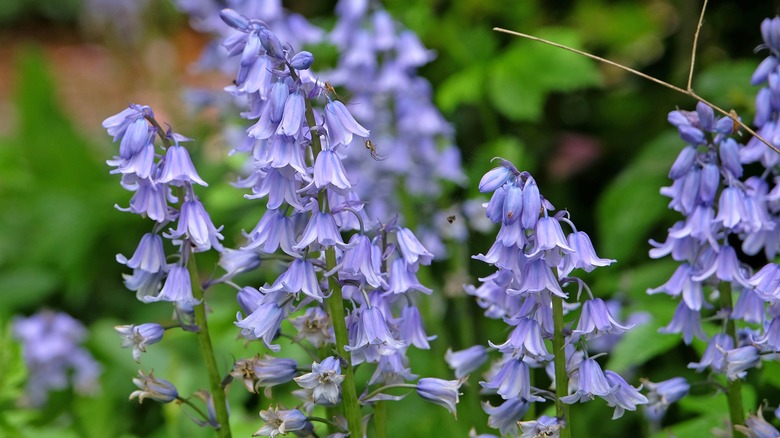5 Bulbs You Shouldn't Be Planting In Containers (& What To Do Instead)
According to data from Bigger Garden, 55% of American households do some kind of gardening. A large portion of this green-thumbed population includes people with access to front and back yards, but if you're living in an urban area or in an apartment, it's likely that you don't have quite as much outdoor space to work with. There are plenty of benefits to growing a container garden, one of the largest being that you can cultivate plants just about anywhere you have access to sunlight, but there are also some limitations when it comes to what exactly you can grow. Many bulbs like daffodils, hyacinths, and tulips can thrive in pots. Others, like gladiolus, camassia, star of Bethlehem, crown imperials, and Spanish bluebells need different growing conditions or shouldn't be planted at all.
Making sure your flower bulbs take root and thrive can be a bit tricky, but as long as you choose the correct varieties for your situation and follow some bulb-planting tips from our expert gardener, you should be good to go. By picking plants that you know are going to do well in containers, you can save yourself quite a bit of unnecessary work, money, and heartbreak. There are, of course, always exceptions to the rule, but avoiding these bulbs you shouldn't be planting in pots will help to narrow down your search and allow you to transform your patio with flowers and plants with less trial and error.
Gladiolus
Gladiolus is a large, uniquely-shaped, showstopper of a flower, so it's natural to want to use them to bring some more interest to your container displays. Because of their size and ideal growing conditions, however, it's likely that they won't thrive in this environment. The stalks of these flowers can get up to 4 feet tall, so they'll quickly become too large for a pot on the front porch. Instead, gladioli should be planted in loosened soil about 4 inches deep and between 6 to 8 inches apart. To ensure they grow to their full height and have enough support, it's also recommended to stake them when you plant.
The most common type of gladiolus, grandiflora hybrids, should be cultivated in a large, open space, but there are a couple of exceptions to this rule. If you still want to grow gladioli in your container garden and you're willing to sacrifice a bit of showiness, you can opt for dwarf grandiflora hybrids or nanus hybrids. These varieties with produce smaller plants and, as a result, fewer blooms, but they can still bring a similar look if you don't have as much room for planting.
Camassia
Camassia is a plant native to the Pacific Northwest that produces unique, star-shaped flowers. Because of this, it's a fantastic addition to help bring a pop of color and texture to your garden, but it's best avoided if you plan to plant in containers or pots. While they don't require much space between each bulb when you plant them — around 6 inches is good — they don't do well with frequent handling. Because of this, they'll thrive when left alone for large amounts of time, eventually multiplying and filling out any gaps left in the space. An especially large, undisturbed container could potentially work for this task, but if you want to guarantee the best longevity and results, it's a safer bet to stick with a traditional bed.
If you ensure your camassia has the necessary conditions to thrive, you'll be rewarded with bright blooms that pop up each spring. As the years go on, you'll also have the ability dig up the clumps that form in the soil and harvest them, planting them elsewhere in the garden. While you could still see some positive results planting camassia in a pot, you likely won't be able to enjoy these long-term benefits.
Star of Bethlehem
Star of Bethlehem is a plant that boasts beautiful, white flowers. It's also, unfortunately, considered invasive in many different areas of the United States. This plant was initially cultivated for its beauty, but, like many other invasive species, things quickly spiraled out of control. When planted in a garden, even if you're working to keep it trimmed back and maintained, it's likely that star of Bethlehem will spread to other areas of your space and begin to take over — it's capable of spreading both through seeds and bulblets.
Because of this, it might be tempting to try and cultivate Star of Bethlehem in a separate container or pot. While this can be a more responsible way to cultivate other fast-growing species, it's better to avoid planting Star of Bethlehem in the first place. If you need any more motivation to opt for other plant species that also boast pretty white flowers, it's also important to note that Star of Bethlehem is highly poisonous both for humans and animals. Despite these warnings, it's still fairly common to find this plant available for sale, so make sure you do your own research and be discerning about what plants you decide to bring into your garden.
Crown imperials
If you're looking for a truly unique bulb to plant in your garden, you've likely stumbled across crown imperials. These flowers are incredibly striking and almost look as though they've been grown upside down. They're commonly used as a pop of color and texture in a border, but they can find a home just about anywhere else in your garden where you're looking for some more interest. Unfortunately, however, they're not the best choice for a container garden. These bulbs can produce plants that grow between 3 and 4 feet tall, so they're simply too large for most pots.
Because they are so tall, it's also necessary to plant these bulbs deep and with a solid amount of distance between each. Theoretically, you could grow one or two in a large pot, but you need to ensure that the bulb is 6 inches deep into the soil and there are 9 to 12 inches between each plant. To create a full display of these flowers, it's necessary to have a solid amount of square footage, so something like a raised garden bed would be more fitting than a pot on a patio.
Spanish bluebells
Spanish bluebells seem like the perfect plant to grow if you're looking to make your garden look like something straight out of a fairytale, but unfortunately, this pretty flower has a much darker side. First, and most notably, they're extremely poisonous. Every part of Spanish bluebells can be toxic if ingested, which is important to note if you have pets or small children. It can also cause skin irritation if handled without gloves, especially if you have sensitive skin.
It's not uncommon for people to choose to cultivate certain plants despite knowing that they're toxic, but it does mean that you have to put in a bit of extra work. One of the biggest things you have to consider is whether or not the plant will spread. Unfortunately, Spanish bluebells grow notoriously quickly and can spread both through seed and bulbs, so even if you plant it in a pot with the intention of keeping it contained, there's a high chance it will spread to other areas. This could cause issues in your own garden, but it could also be dangerous for your neighbors, especially if you're living in a more compact space like an apartment complex. Because of this, it's best to avoid Spanish bluebells altogether.
